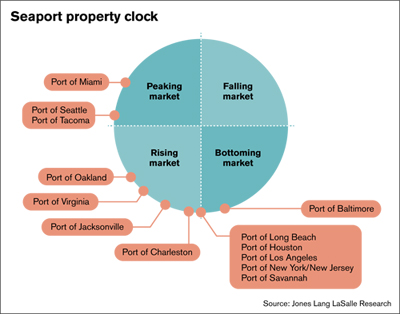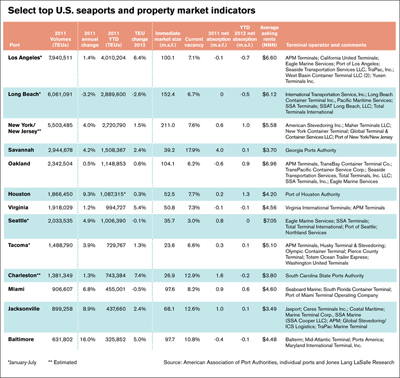U.S. Ports Update: Panama Canal preparation heats up
In anticipation of the Panama Canal expansion in 2014, the fight for market share of inbound cargo remains fierce among top U.S. ports.
Latest Logistics News
Warehouse/DC Automation & Technology: It’s “go time” for investment 31st Annual Study of Logistics and Transportation Trends Warehouse/DC equipment survey: It’s “go time” for investment Global Logistics/3PL Special Digital Issue 2022 Motor Freight 2022: Pedal to the Metal More Special ReportsInfluenced by an evolving maritime logistics industry, global trade transformations, the extension of the Panama Canal, and the growth of U.S. exports, U.S. port analysts see a bright, long-term future for our nation’s gateways. Today, capital is being poured into seaport infrastructure from both the private and public sectors, responding to increased demand for port-centric warehouse and distribution space.
According to Jones Lang LaSalle’s fourth annual seaport report, the U.S. East Coast ports will be especially competitive in 2013. “Developers, investment interests, and supply chain executives remain optimistic about our nation’s seaports,” says John Carver, head of Jones Lang LaSalle’s Ports Airports and Global Infrastructure (PAGI) group.
As reported in the firm’s earlier studies, commercial real estate surrounding major U.S. seaports continues to outperform the broader industrial market. But the report may do little to ease the minds of U.S. port authorities that argue that more must be done to make their operations efficient.
“Despite substantial investments by port authorities and private-sector business partners, inadequate infrastructure connecting ports to landside transportation networks and water-side shipping lanes often creates bottlenecks that result in congestion, productivity losses, and a global economic disadvantage for America,” says Kurt Nagle, American Association of Port Authorities (AAPA), president and CEO. “These congestion issues and productivity losses have the potential to stymie our ability to compete internationally.”
Nonetheless, both the AAPA and PAGI analysts agree that the nation’s leading ocean cargo gateways are spending the most on structural improvements. The Jones Lang LaSalle’s report, which analyzes the health of major domestic container seaports and their surrounding real estate, also reveals that:
Exports are creating inland development opportunities. U.S. exports are now creating back-haul opportunities and are driving new connections between domestic maritime ports, inland destinations, and their surrounding distribution real estate markets.
Investment is pouring into ports. At least $13 billion of public investment is earmarked for port development in the next decade.
Limited options are available for large space uses. Only 20 blocks of space are available for users requiring 250,000 square feet within five miles of a major U.S. port.
Here’s how the nation’s leading seaports are putting investment to work to ensure their position in a competitive race that’s only going to heat up in 2014.

The Port Index: Changes at the top
Success for some ports is detailed in the Jones Lang LaSalle Port Index, which ranks U.S. ports on terminal operating and real estate market factors—including the port’s proximity to concentrated population and manufacturing hubs.
For the first time in its four-year history, the index has rated the Port of New York and New Jersey at the top of the list, followed closely by the ports of Los Angeles and Long Beach.
According to Aaron Ahlburn, head of industrial research for Jones Lang LaSalle Americas, these three major seaports profit from several factors: “First, they support vast local population centers; second, infill vacancy around the ports themselves remains tight and new development is prized; and third, they are connected to less land-constrained, adjacent markets that facilitate ‘big-box’ logistics space.”
Ports like Seattle, with strong demographics and a sizeable consumer base within a 24-hour trucking window, have remained high on the Index. Similarly, others that are competitive shipping destinations, such as Houston, Miami, and Baltimore, are moving to re-establish more solid industrial leasing and investment conditions.
Ports that may not benefit from immediate large populations such as Hampton Roads, Jacksonville, Savannah, and Charleston remain important throughput hubs to move goods and materials into other parts of the country. However, Savannah, Charleston, Jacksonville, and Baltimore have higher vacancy rates in their surrounding port markets, but have experienced the fastest growth in occupancy over the last 18 months. “We expect development to remain cautious as these markets continue to strengthen over the coming quarters,” says Ahlburn.
Many port markets that experienced significant “big box” development prior to the downturn have not been able to burn off their excess construction. Houston, Charleston, Savannah, and Jacksonville have double-digit vacancy rates.
But there are fewer than 10 existing warehouse or distribution facilities of more than 500,000 square feet within a 15-mile radius surrounding the major seaports, according to the report. For large users in markets such as Southern California or the Northeast, that means transporting cargo to inland destinations—inland ports—or bidding against other tenants for space.
This not only provides opportunities to develop smaller distribution centers or redevelop old ones, says Carver, “but it also serves to evaluate supply chain requirements, adapt potential transportation routes, and assess competitive drayage options.”
Florida ports poised for growth
Miami-Dade County announced last month that the contracting phase of its project to deepen the Port of Miami’s channel to minus 50 feet has begun with the solicitation of bids by the U.S. Army Corps of Engineers. Construction is scheduled to begin in early 2013 and be completed in time for the opening of the expanded Panama Canal in early 2015.
Bill Johnson, the port’s director, says that a deeper channel will provide ships with a more efficient, reliable, and safe navigational route into Miami. “As the closest port to the Panama Canal, we’re well positioned to capture new trade opportunities,” he says. “The port will double its cargo traffic over the next several years.”
Meanwhile, a smaller, but important regional port to the north is undertaking three key expansion projects over the next six years. According to authorities at Port Everglades, the Broward County gateway will add five berths, widen and deepen the channel to 50 feet, and bring freight rail into the port.
According to spokesmen, Port Everglades must take these vital expansion steps to remain competitive with seaports in the Southeastern U.S. “The port already handles Post-Panamax ships,” says Steve Cernak, the port’s chief executive and director. “But they must be lightly loaded, which is inefficient and drive carriers away to other ports.”
Gulf ports plan for inbound
The Port of New Orleans and Houston continue to vie for inbound first call. In fact, German ocean carrier Hamburg Sud recently added the Port of New Orleans to a new weekly service to Latin America through a space charter agreement with Hapag-Lloyd. The service will connect New Orleans with Caucedo, Dominican Republic; Buenos Aires, Argentina; Montevideo, Uruguay; Rio Grande, Mexico; and Suape, Santos, Navegantes and Rio de Janeiro, Brazil.
“Hamburg Sud is among the world’s top 20 container lines, and we’re thrilled that they are now calling on the Port of New Orleans,” says Port President and CEO Gary LaGrange. “This new service will allow our customers better access and more frequent service to Latin American markets.”
The Port of Houston, meanwhile, is ranked first in U.S. foreign tonnage, second in total U.S. tonnage, and third in U.S. export tonnage. Federal customs revenue collected from the port’s cargo exceeds $768 million per year. The $171 million in harbor maintenance tax collected annually from channel-related activities are far more than the $40 million to $50 million needed annually for adequate channel maintenance.
Compared with other Gulf and East Coast ports, Houston’s ship channel receives a fraction of funds on a per-ton-of-cargo basis—9 cents where the average is 44 cents—resulting in inadequate channel maintenance. The U.S. Army Corps of Engineers is responsible for maintaining the channel, which is subject to constant siltation and erosion, based on money appropriated by Congress. Despite strong and bipartisan advocacy from the Harris County Congressional delegation, enormous pressures on the federal budget make it challenging to fund Corps projects nationwide.
West Coast promise
The Los Angeles Harbor Commission recently approved $7.5 million for the final phase of the Port of Los Angeles’ Main Channel Deepening Project (MCDP). The project has taken the Port’s main navigational channels and basins to a 53-foot depth, ensuring that the nation’s number one gateway for containerized trade can accommodate container ships of all sizes for decades to come.
“Channel deepening has been our single-most important infrastructure priority,” says Port of Los Angeles Executive Director Geraldine Knatz, Ph.D.
Dredging of the port’s main channel and turning basins has already been completed. The final phase of the project involves removal of dredge surcharge material and completion of a shallow water habitat in the outer harbor.
The port’s nine container terminal tenants rely on the port’s deep channels to move cargo. Container terminals generate about 74 percent of port revenues and help facilitate hundreds of thousands of direct and indirect jobs throughout Southern California. The 15-year, $370 million project will be completed in early 2013.
The Port of Oakland, meanwhile, continues its measured growth. When the port’s executive director, Omar Benjamin, hired James J. Kwon to run the Maritime Division five years ago, ocean cargo industry insiders regarded the move as inspired.
Rather than choosing a port functionary for the post, Benjamin sought out a savvy, and worldly deal-maker. Kwon, who speaks both Korean and Chinese, was charged with making Oakland the first port of call for inbound transpacific cargoes and with keeping the gateway positioned as the leading outbound quay on the West Coast.
Kwon had the connections and experience to get the job done, too. Under his watch, Oakland welcomed the largest containership ever to call any seaport in North America. The MSC Fabiola—a 12,562 TEU (twenty-foot equivalent-unit) vessel—is part of the fleet of the world’s second-largest shipping company.
Benjamin has also been recently praised for playing a key role in the port’s redevelopment of the former Oakland Army Base (OAB). The OAB project involves a transformation of the former base into a world-class trade and logistics center that will strengthen Oakland’s position as an export hub. The port handles 99 percent of all containerized goods in Northern California, and agricultural products represent approximately 40 percent of the total value of exports.

Article Topics
Special Reports News & Resources
Warehouse/DC Automation & Technology: It’s “go time” for investment 31st Annual Study of Logistics and Transportation Trends Warehouse/DC equipment survey: It’s “go time” for investment Global Logistics/3PL Special Digital Issue 2022 Motor Freight 2022: Pedal to the Metal Top 50 Trucking Companies: The strong get stronger 2019 Top 50 Trucking Companies: Working to Stay on Top More Special ReportsLatest in Logistics
Investor expectations continue to influence supply chain decision-making The Next Big Steps in Supply Chain Digitalization Warehouse/DC Automation & Technology: Time to gain a competitive advantage The Ultimate WMS Checklist: Find the Perfect Fit Under-21 driver pilot program a bust with fleets as FMCSA seeks changes Diesel back over $4 a gallon; Mideast tensions, other worries cited Four U.S. railroads file challenges against FRA’s two-person crew mandate, says report More LogisticsAbout the Author
Subscribe to Logistics Management Magazine

Find out what the world's most innovative companies are doing to improve productivity in their plants and distribution centers.
Start your FREE subscription today.
April 2023 Logistics Management

Latest Resources















